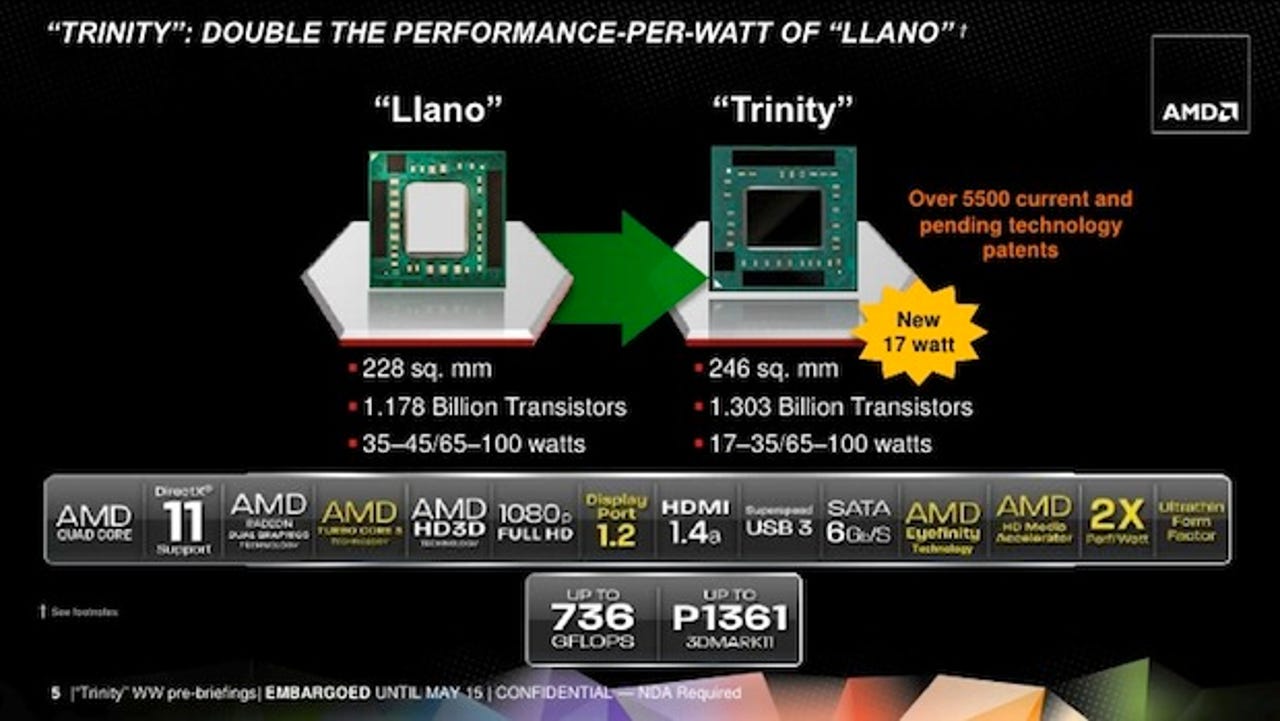AMD's 'Trinity' challenge to Intel's Ivy Bridge: Will it convince OEMs?

AMD has officially lifted the lid on the first batch of second-generation A-Series Accelerated Processing Units (APUs), codenamed "Trinity", which, on paper at any rate, seem to give Intel's Ivy Bridge silicon a real run for its money.
But can AMD convince the OEMs to jump on board the Trinity bandwagon?

AMD is launching five new APUs today. The A10-4600M, A8-4500M, and A6-4400M, which have been designed for notebooks systems, and the A10-4655M and A6-4455M that will find a home in ultrathin systems.
Trinity is the first outing for AMD's Piledriver architecture, a follow-on to the Bulldozer architecture which formed the basis of the FX range of processors. However, unlike Intel who switched to 22-nanometer architecture with Ivy Bridge, AMD is still using the older 32-nanometer architecture for Trinity. This means that in order to accommodate the 125 million extra transistors in the second-generation processors, the size of the die has had to increase significantly: from 228 mm² for the first-generation Llano A-series APUs, to 246 mm² for Trinity parts.
AMD has put a lot of work into making Trinity the ideal choice for OEMs building mobile systems. First, the power consumption -- measured in TDP -- for these parts has been cut from 35W and 45W for the first-generation dual- and quad-core APUs respectively, down to 17W for the dual-core Trinity APUs, and 35W for the quad-core APUs. These power consumptions are in line with Intel's Ivy Bridge parts.
Lower power consumption means less heat generated and longer battery life for mobile devices. Both of these are important to OEMs wanting to build thin and light devices. AMD claims that Trinity will allow OEMs to build mobile systems that could last up to 12 hours off a single charge.
But there's one area where Trinity has a clear advantage -- at least on paper --over Ivy Bridge, and that's the GPU. In benchmark tests carried out by AMD, the HD 7000 series GPU incorporated into Trinity has a clear lead over the Intel's Ivy Bridge GPU.
A more powerful GPU means better gaming, and better HD video quality. Also, because Trinity supports the OpenCL standard, this allows the GPU to be leveraged to carry out computational tasks. This allows third-party software such as Adobe Photoshop or the Flash Player plug-in to offload some of the work that would normally be carried out by the CPU onto the GPU.
AMD also claims that Trinity-powered hardware will be cheaper than equivalent Intel-powered systems, with thin and light systems starting at $699. If OEMs can deliver hardware at this price point then AMD-powered hardware will have a $100 advantage over similar Intel-powered systems.
AMD claims that big-name OEMs such as Asus, HP, Lenovo, Samsung, Toshiba, and Acer will unveil mobile systems based around Trinity shortly.
While it seems that AMD has silicon that rivals that of Intel, it remains to be see whether the company can persuade OEMs to use its parts. Intel, whose chips are used in some 80 percent of the world's PCs, is pushing for ultrabooks to be powered by its Ivy Bridge silicon. The company has invested some $300 million in an investment fund to help smaller companies develop technology to use in future ultrabooks, and expects that these devices will account for 40 percent of all consumer laptop sales by the holiday season.
Not only was Intel the first to market with Ivy Bridge, the company has enormous resources at its disposal to throw at convincing OEMs -- not to mention buyers -- that its silicon is the best choice.
AMD's ace up its sleeve with Trinity is the GPU. While Intel has the CPU market stitched up tight when it comes to CPUs, it's not a big name when it comes to GPU technology. AMD on the other hand has the Radeon line of GPUs that OEMs are familiar with and trust. If it can leverage its GPU relationship with the OEMs to push its APUs, then it is in a position where it could put pressure on Intel.
It's now down to the OEMs.
Related:
Build your own "Ivy Bridge" desktop PC
| Image Gallery: Build your own "Ivy Bridge" desktop PC | ||||||
- AMD unveils 'Trinity' A-Series APUs
- CNET UK: AMD A Series ‘Trinity’ processors: what you need to know
- ZDNet: Intel wants to be inside the iPad
- Intel announces Ivy Bridge chips for high-end laptops and desktops
- Intel’s Ivy Bridge: Aggressive launch, but a lot of wild cards
- Why Intel’s 22nm technology really matters